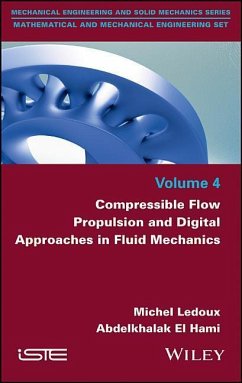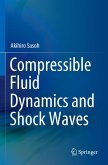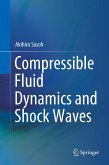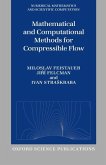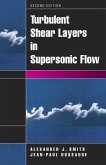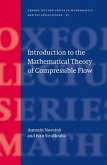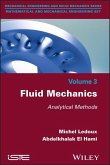Michel Ledoux, Abdelkhalak El Hami
Compressible Flow Propulsion and Digital Approaches in Fluid Mechanics
Schade – dieser Artikel ist leider ausverkauft. Sobald wir wissen, ob und wann der Artikel wieder verfügbar ist, informieren wir Sie an dieser Stelle.
Michel Ledoux, Abdelkhalak El Hami
Compressible Flow Propulsion and Digital Approaches in Fluid Mechanics
- Gebundenes Buch
- Merkliste
- Auf die Merkliste
- Bewerten Bewerten
- Teilen
- Produkt teilen
- Produkterinnerung
- Produkterinnerung
This book aims to provide an efficient methodology of solving a fluid mechanics problem, based on an awareness of the physical. It meets different objectives of the student, the future engineer or scientist: Simple sizing calculations are required to master today's numerical approach for solving complex practical problems.
Andere Kunden interessierten sich auch für
![Compressible Fluid Dynamics and Shock Waves Compressible Fluid Dynamics and Shock Waves]() Akihiro SasohCompressible Fluid Dynamics and Shock Waves134,99 €
Akihiro SasohCompressible Fluid Dynamics and Shock Waves134,99 €![Compressible Fluid Dynamics and Shock Waves Compressible Fluid Dynamics and Shock Waves]() Akihiro SasohCompressible Fluid Dynamics and Shock Waves134,99 €
Akihiro SasohCompressible Fluid Dynamics and Shock Waves134,99 €![Mathematical and Computational Methods for Compressible Flow Mathematical and Computational Methods for Compressible Flow]() Miloslav FeistauerMathematical and Computational Methods for Compressible Flow221,99 €
Miloslav FeistauerMathematical and Computational Methods for Compressible Flow221,99 €![Proceedings of the 9th Asian Joint Workshop on Thermophysics and Fluid Science, 27-30 November 2022, Utsunomiya, Japan Proceedings of the 9th Asian Joint Workshop on Thermophysics and Fluid Science, 27-30 November 2022, Utsunomiya, Japan]() Proceedings of the 9th Asian Joint Workshop on Thermophysics and Fluid Science, 27-30 November 2022, Utsunomiya, Japan164,99 €
Proceedings of the 9th Asian Joint Workshop on Thermophysics and Fluid Science, 27-30 November 2022, Utsunomiya, Japan164,99 €![Turbulent Shear Layers in Supersonic Flow Turbulent Shear Layers in Supersonic Flow]() Alexander J. SmitsTurbulent Shear Layers in Supersonic Flow164,99 €
Alexander J. SmitsTurbulent Shear Layers in Supersonic Flow164,99 €![Introduction to the Mathematical Theory of Compressible Flow Introduction to the Mathematical Theory of Compressible Flow]() A. NovotnyIntroduction to the Mathematical Theory of Compressible Flow212,99 €
A. NovotnyIntroduction to the Mathematical Theory of Compressible Flow212,99 €![Fluid Mechanics Fluid Mechanics]() Michel LedouxFluid Mechanics164,99 €
Michel LedouxFluid Mechanics164,99 €-
-
-
This book aims to provide an efficient methodology of solving a fluid mechanics problem, based on an awareness of the physical. It meets different objectives of the student, the future engineer or scientist: Simple sizing calculations are required to master today's numerical approach for solving complex practical problems.
Produktdetails
- Produktdetails
- Verlag: Wiley
- Seitenzahl: 288
- Erscheinungstermin: 28. März 2017
- Englisch
- Abmessung: 236mm x 157mm x 20mm
- Gewicht: 1633g
- ISBN-13: 9781786301123
- ISBN-10: 1786301121
- Artikelnr.: 47297870
- Herstellerkennzeichnung
- Libri GmbH
- Europaallee 1
- 36244 Bad Hersfeld
- gpsr@libri.de
- Verlag: Wiley
- Seitenzahl: 288
- Erscheinungstermin: 28. März 2017
- Englisch
- Abmessung: 236mm x 157mm x 20mm
- Gewicht: 1633g
- ISBN-13: 9781786301123
- ISBN-10: 1786301121
- Artikelnr.: 47297870
- Herstellerkennzeichnung
- Libri GmbH
- Europaallee 1
- 36244 Bad Hersfeld
- gpsr@libri.de
Michel Ledoux, Professor at University of Rouen. Abdelkhalak Elhami, Professor at INSA Rouen.
Preface ix
Chapter 1 The Flow of Viscous Fluids Flow in the Vicinity of a Wall:
Boundary Layers and Films 1
1.1 Introduction 1
1.2 Characteristics and classification of boundary layers 1
1.2.1 Boundary layers - various approaches 4
1.3 The outer boundary layers: an analytical approach 4
1.3.1 The laminar boundary layer developed by a flat plate in a uniform
flow 4
1.3.2 The turbulent boundary layer 8
1.4 Examples of analytical approach: outer flows 13
1.5 Examples of analytical approach: inner flows 23
1.6 Outer boundary layers: integral methods 43
1.6.1 Principle of the integral method 43
1.6.2 Applications of integral methods 46
1.7 Channels and films 62
Chapter 2 One-dimensional Compressible Flows: Fully Reversible Flows 77
2.1 Introduction 77
2.2 One-dimensional adiabatic and reversible flows 78
2.2.1 Hypotheses adopted 78
2.2.2 Writing the laws 79
2.2.3 Other useful relations 79
2.2.4 Fundamental relations 85
2.2.5 Calculation of flow rate in a piping system 88
2.2.6 De Laval nozzle 92
2.3 Applications Reversible adiabatic flows 95
Chapter 3 One-dimensional Compressible Flows: Irreversible Flows 125
3.1 Introduction 125
3.2 Irreversible flow: straight shock wave 125
3.2.1 Establishing the fundamental relations 125
3.2.2 Applications 129
3.3 Partially irreversible flows: shock wave in a nozzle 144
3.3.1 Change of the generating state by the shock wave 144
3.3.2 Applications 146
3.4 Conclusion 156
Chapter 4 Modeling and Numerical Simulations 159
4.1 Introduction 159
4.2 Methodology description and simulation approach 160
4.3 Modeling and simulation of coupled systems 163
4.3.1 Mathematical formulation Behavior equations 163
4.3.2 Fluid-structure coupling conditions 164
4.4 Variational formulation 165
4.5 Finite element approximation 165
4.5.1 Approximation of physical unknowns 166
4.5.2 Integration of variational forms 166
4.6 The vibro-acoustic problem 166
4.7 The hydro-elastic problem 167
4.8 Applications 168
4.9 Conclusion 196
Chapter 5 Numerical Simulation of a Vertical-axis Wind Turbine 197
5.1 Introduction 197
5.2 Construction of the rotor geometry and definition of the computational
domain 197
5.2.1 Mesh 199
5.2.2 Discretization scheme 202
5.2.3 System resolution and convergence 205
5.3 Analysis of the results 206
5.3.1 Validation of the CFD model 206
5.3.2 Influence of the characteristic parameters 210
5.4 Conclusion 216
Appendix 217
Bibliography 265
Index 269
Chapter 1 The Flow of Viscous Fluids Flow in the Vicinity of a Wall:
Boundary Layers and Films 1
1.1 Introduction 1
1.2 Characteristics and classification of boundary layers 1
1.2.1 Boundary layers - various approaches 4
1.3 The outer boundary layers: an analytical approach 4
1.3.1 The laminar boundary layer developed by a flat plate in a uniform
flow 4
1.3.2 The turbulent boundary layer 8
1.4 Examples of analytical approach: outer flows 13
1.5 Examples of analytical approach: inner flows 23
1.6 Outer boundary layers: integral methods 43
1.6.1 Principle of the integral method 43
1.6.2 Applications of integral methods 46
1.7 Channels and films 62
Chapter 2 One-dimensional Compressible Flows: Fully Reversible Flows 77
2.1 Introduction 77
2.2 One-dimensional adiabatic and reversible flows 78
2.2.1 Hypotheses adopted 78
2.2.2 Writing the laws 79
2.2.3 Other useful relations 79
2.2.4 Fundamental relations 85
2.2.5 Calculation of flow rate in a piping system 88
2.2.6 De Laval nozzle 92
2.3 Applications Reversible adiabatic flows 95
Chapter 3 One-dimensional Compressible Flows: Irreversible Flows 125
3.1 Introduction 125
3.2 Irreversible flow: straight shock wave 125
3.2.1 Establishing the fundamental relations 125
3.2.2 Applications 129
3.3 Partially irreversible flows: shock wave in a nozzle 144
3.3.1 Change of the generating state by the shock wave 144
3.3.2 Applications 146
3.4 Conclusion 156
Chapter 4 Modeling and Numerical Simulations 159
4.1 Introduction 159
4.2 Methodology description and simulation approach 160
4.3 Modeling and simulation of coupled systems 163
4.3.1 Mathematical formulation Behavior equations 163
4.3.2 Fluid-structure coupling conditions 164
4.4 Variational formulation 165
4.5 Finite element approximation 165
4.5.1 Approximation of physical unknowns 166
4.5.2 Integration of variational forms 166
4.6 The vibro-acoustic problem 166
4.7 The hydro-elastic problem 167
4.8 Applications 168
4.9 Conclusion 196
Chapter 5 Numerical Simulation of a Vertical-axis Wind Turbine 197
5.1 Introduction 197
5.2 Construction of the rotor geometry and definition of the computational
domain 197
5.2.1 Mesh 199
5.2.2 Discretization scheme 202
5.2.3 System resolution and convergence 205
5.3 Analysis of the results 206
5.3.1 Validation of the CFD model 206
5.3.2 Influence of the characteristic parameters 210
5.4 Conclusion 216
Appendix 217
Bibliography 265
Index 269
Preface ix
Chapter 1 The Flow of Viscous Fluids Flow in the Vicinity of a Wall:
Boundary Layers and Films 1
1.1 Introduction 1
1.2 Characteristics and classification of boundary layers 1
1.2.1 Boundary layers - various approaches 4
1.3 The outer boundary layers: an analytical approach 4
1.3.1 The laminar boundary layer developed by a flat plate in a uniform
flow 4
1.3.2 The turbulent boundary layer 8
1.4 Examples of analytical approach: outer flows 13
1.5 Examples of analytical approach: inner flows 23
1.6 Outer boundary layers: integral methods 43
1.6.1 Principle of the integral method 43
1.6.2 Applications of integral methods 46
1.7 Channels and films 62
Chapter 2 One-dimensional Compressible Flows: Fully Reversible Flows 77
2.1 Introduction 77
2.2 One-dimensional adiabatic and reversible flows 78
2.2.1 Hypotheses adopted 78
2.2.2 Writing the laws 79
2.2.3 Other useful relations 79
2.2.4 Fundamental relations 85
2.2.5 Calculation of flow rate in a piping system 88
2.2.6 De Laval nozzle 92
2.3 Applications Reversible adiabatic flows 95
Chapter 3 One-dimensional Compressible Flows: Irreversible Flows 125
3.1 Introduction 125
3.2 Irreversible flow: straight shock wave 125
3.2.1 Establishing the fundamental relations 125
3.2.2 Applications 129
3.3 Partially irreversible flows: shock wave in a nozzle 144
3.3.1 Change of the generating state by the shock wave 144
3.3.2 Applications 146
3.4 Conclusion 156
Chapter 4 Modeling and Numerical Simulations 159
4.1 Introduction 159
4.2 Methodology description and simulation approach 160
4.3 Modeling and simulation of coupled systems 163
4.3.1 Mathematical formulation Behavior equations 163
4.3.2 Fluid-structure coupling conditions 164
4.4 Variational formulation 165
4.5 Finite element approximation 165
4.5.1 Approximation of physical unknowns 166
4.5.2 Integration of variational forms 166
4.6 The vibro-acoustic problem 166
4.7 The hydro-elastic problem 167
4.8 Applications 168
4.9 Conclusion 196
Chapter 5 Numerical Simulation of a Vertical-axis Wind Turbine 197
5.1 Introduction 197
5.2 Construction of the rotor geometry and definition of the computational
domain 197
5.2.1 Mesh 199
5.2.2 Discretization scheme 202
5.2.3 System resolution and convergence 205
5.3 Analysis of the results 206
5.3.1 Validation of the CFD model 206
5.3.2 Influence of the characteristic parameters 210
5.4 Conclusion 216
Appendix 217
Bibliography 265
Index 269
Chapter 1 The Flow of Viscous Fluids Flow in the Vicinity of a Wall:
Boundary Layers and Films 1
1.1 Introduction 1
1.2 Characteristics and classification of boundary layers 1
1.2.1 Boundary layers - various approaches 4
1.3 The outer boundary layers: an analytical approach 4
1.3.1 The laminar boundary layer developed by a flat plate in a uniform
flow 4
1.3.2 The turbulent boundary layer 8
1.4 Examples of analytical approach: outer flows 13
1.5 Examples of analytical approach: inner flows 23
1.6 Outer boundary layers: integral methods 43
1.6.1 Principle of the integral method 43
1.6.2 Applications of integral methods 46
1.7 Channels and films 62
Chapter 2 One-dimensional Compressible Flows: Fully Reversible Flows 77
2.1 Introduction 77
2.2 One-dimensional adiabatic and reversible flows 78
2.2.1 Hypotheses adopted 78
2.2.2 Writing the laws 79
2.2.3 Other useful relations 79
2.2.4 Fundamental relations 85
2.2.5 Calculation of flow rate in a piping system 88
2.2.6 De Laval nozzle 92
2.3 Applications Reversible adiabatic flows 95
Chapter 3 One-dimensional Compressible Flows: Irreversible Flows 125
3.1 Introduction 125
3.2 Irreversible flow: straight shock wave 125
3.2.1 Establishing the fundamental relations 125
3.2.2 Applications 129
3.3 Partially irreversible flows: shock wave in a nozzle 144
3.3.1 Change of the generating state by the shock wave 144
3.3.2 Applications 146
3.4 Conclusion 156
Chapter 4 Modeling and Numerical Simulations 159
4.1 Introduction 159
4.2 Methodology description and simulation approach 160
4.3 Modeling and simulation of coupled systems 163
4.3.1 Mathematical formulation Behavior equations 163
4.3.2 Fluid-structure coupling conditions 164
4.4 Variational formulation 165
4.5 Finite element approximation 165
4.5.1 Approximation of physical unknowns 166
4.5.2 Integration of variational forms 166
4.6 The vibro-acoustic problem 166
4.7 The hydro-elastic problem 167
4.8 Applications 168
4.9 Conclusion 196
Chapter 5 Numerical Simulation of a Vertical-axis Wind Turbine 197
5.1 Introduction 197
5.2 Construction of the rotor geometry and definition of the computational
domain 197
5.2.1 Mesh 199
5.2.2 Discretization scheme 202
5.2.3 System resolution and convergence 205
5.3 Analysis of the results 206
5.3.1 Validation of the CFD model 206
5.3.2 Influence of the characteristic parameters 210
5.4 Conclusion 216
Appendix 217
Bibliography 265
Index 269

